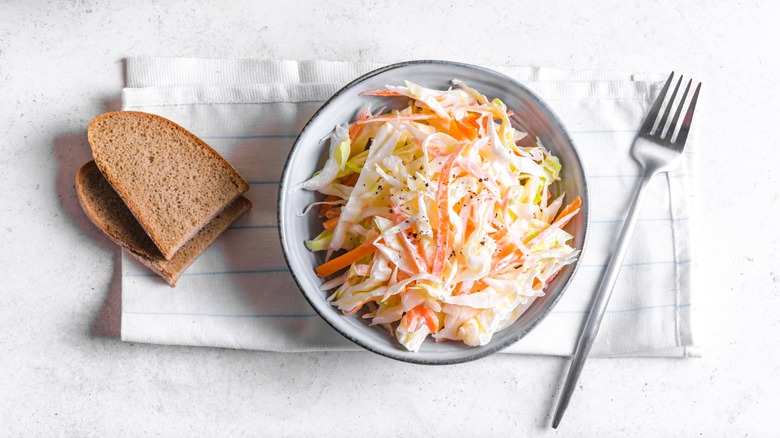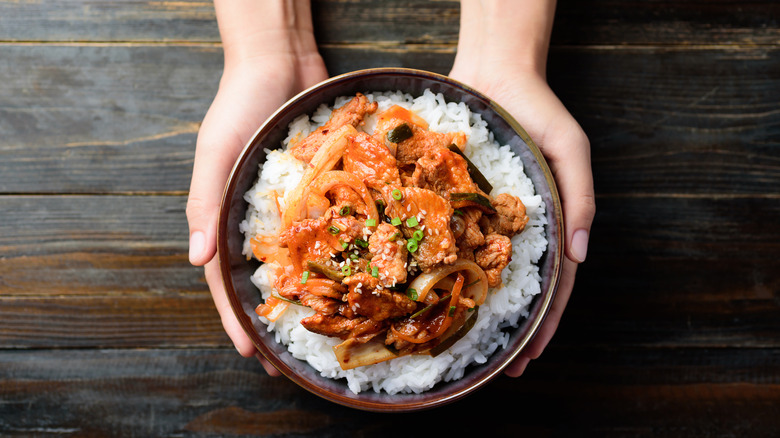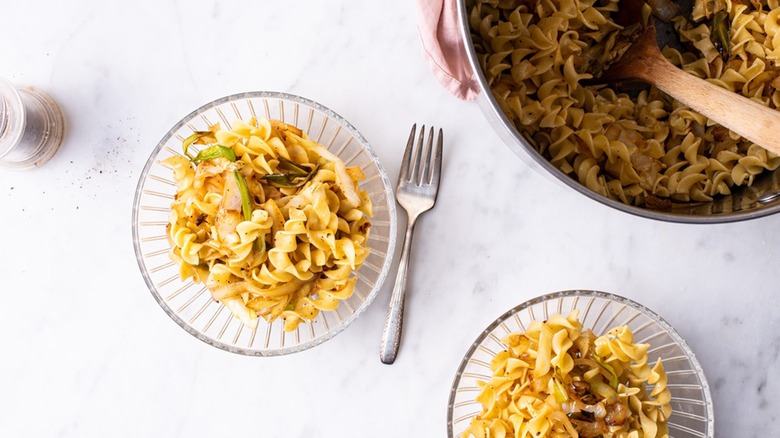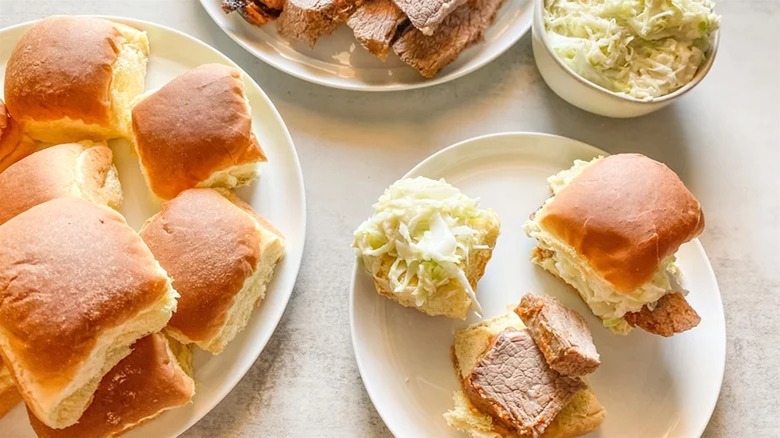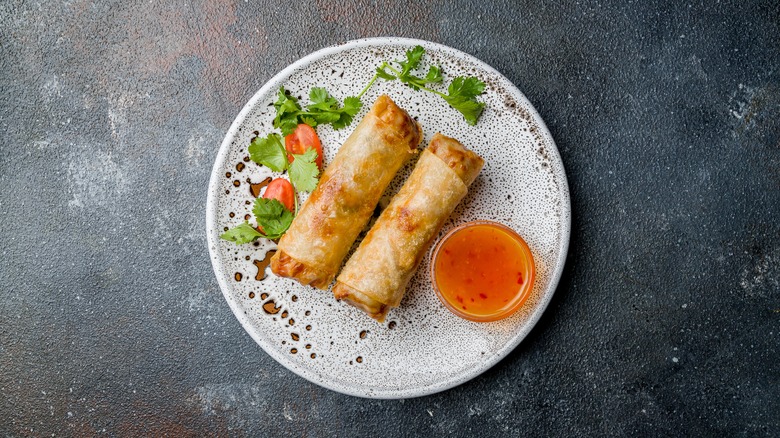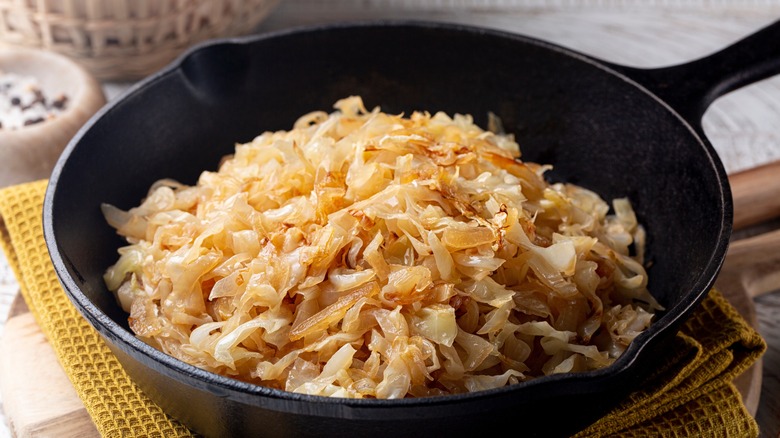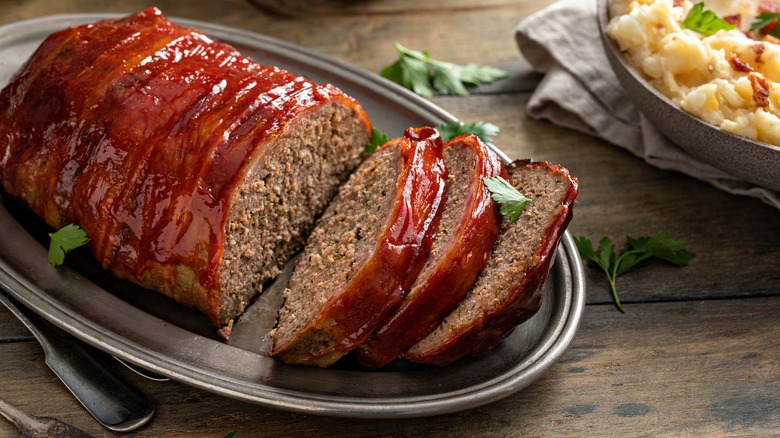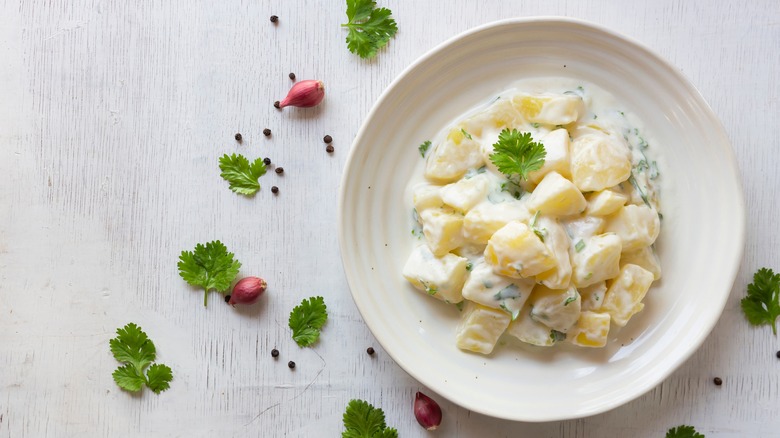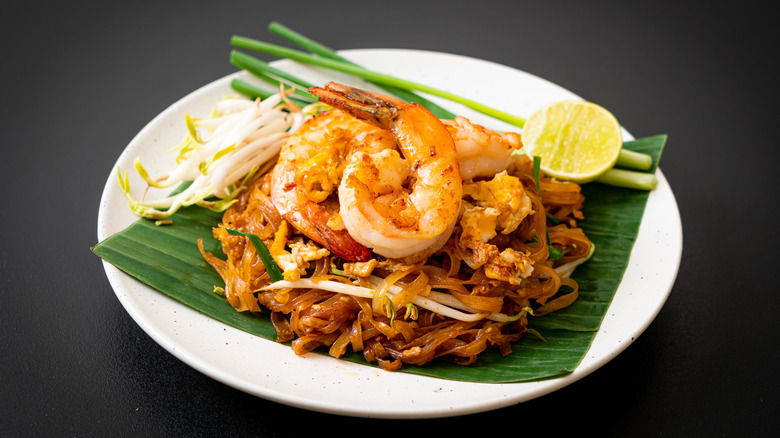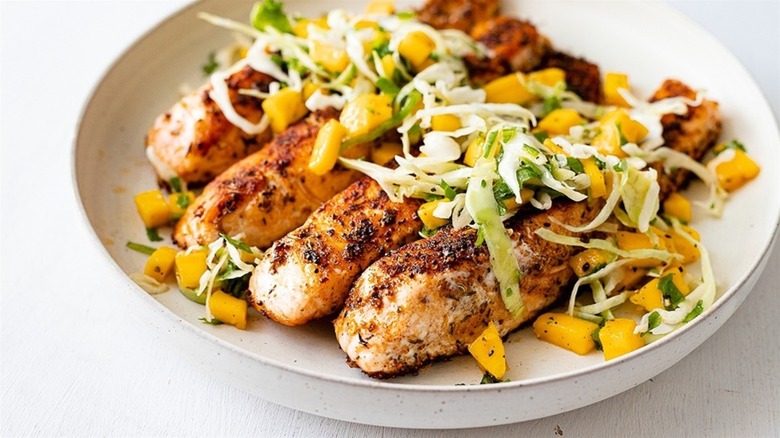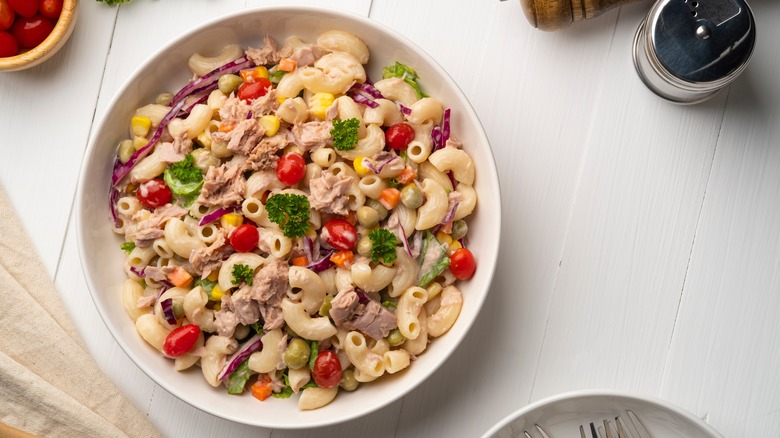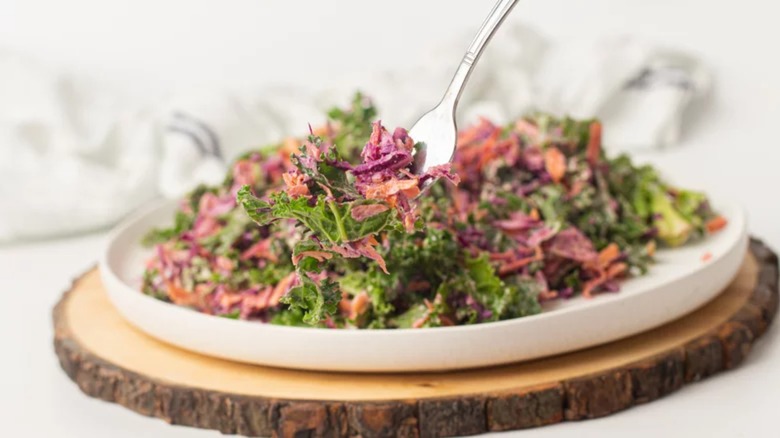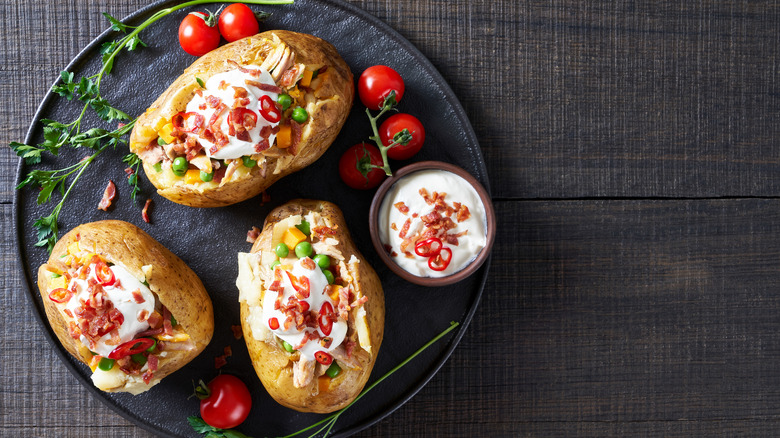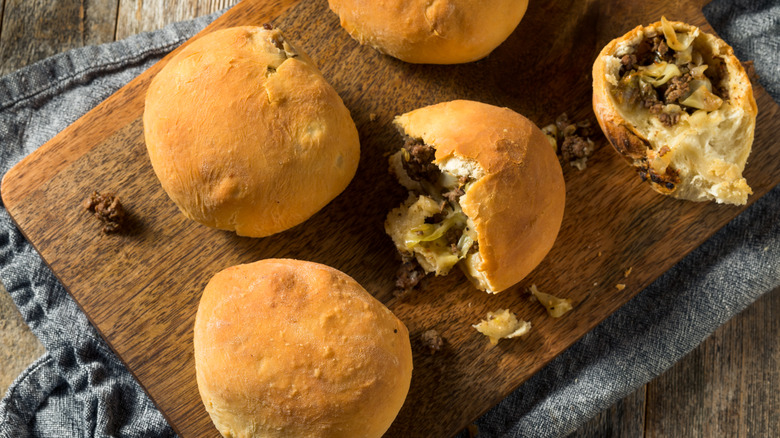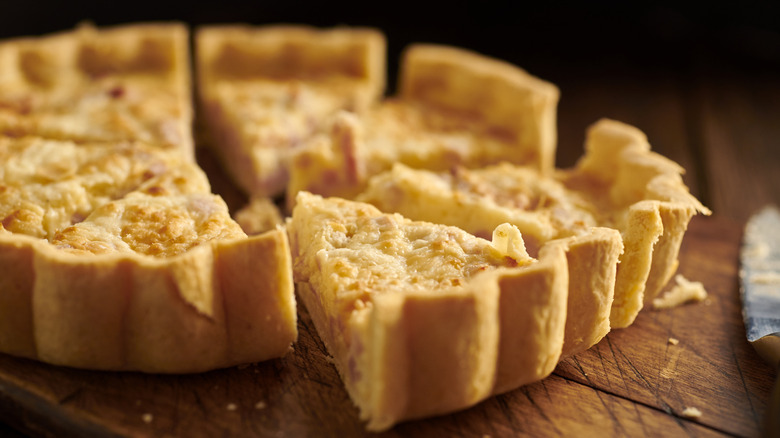14 Surprising Ways To Use Leftover Coleslaw
Most suggestions for using up barbecue leftovers neglect that most loyal of side dishes — coleslaw. For some, this crunchy mixture of cabbage and carrots doused in a mayonnaise and vinegar sauce is nothing more than a ceremonial nod toward nutrients to balance the avalanche of meat coming from the grill. For others, it provides some much-needed textural variation to the proceedings. Some loathe it, some love it, but wherever you fall on the spectrum, it's hard to deny that there is almost always too much of it. You might run out of hamburger buns or underestimate your guests' appetite for hot dogs, but rarely has anyone turned to a newly empty bowl and said, "Oh no. We're out of coleslaw." More often than not, you have the opposite problem — way too much of it.
In these moments, coleslaw might end up straight in the compost, but it's worth pausing before you throw it out. Even if you don't like the crunchy salad on its own, you might love it when it's been repurposed into a new dish. After all, a traditional coleslaw recipe is just cabbage, carrots, mayo, and vinegar, all of which fit perfectly into a wide range of other recipes. So, without further ado, let's dig into all the ways you can use leftover coleslaw and marvel at its surprising versatility.
1. Use it to garnish stir-fries
One of the key features of coleslaw is its crunchiness. Cabbage and carrots are equipped with a robust texture that keeps them crunchy even after they've been marinating in mayo and vinegar in the fridge for a few days. In fact, some might say that they're a little too crisp when fresh, and letting them soften ever so slightly for 24 hours or more makes them tastier. Their day-old texture is perfect for garnishing otherwise soft dishes like rice and noodle stir-fries. With creaminess from the mayo and a slight sharpness from the vinegar, they provide flavor as well as texture, giving you a dressing and a garnish all in one.
The key to adding leftover coleslaw to a stir-fry recipe is to use it sparingly. You don't want to turn a delicious chicken and rice dish into a dense, cabbage-heavy bowl of mayo-drenched grains and vegetables. Start by making your favorite stir-fry and wait to add the coleslaw until the very end. Treat it as a garnish rather than one of the main ingredients, and you'll get just the right amount of texture and flavor from it.
2. Make cabbage and noodles
Cabbage is an unglamorous ingredient that might bring to mind tasteless soups for freezing winter nights, but it deserves to be re-evaluated. Just look to Eastern Europe, where the humble veggie is a staple ingredient that is prepared in countless ways in recipes that fit every occasion. If you want to challenge your perception of cabbage, our cabbage and noodles recipe is a great place to start. Sweet, savory, and a bit smokey, it is full of unexpected flavors delivered on a bed of delicious egg noodles.
To make it, you'll need to start by caramelizing the cabbage with onion. Using coleslaw for this step will make it even more delicious, since it brings its own seasoning to the table. You will need to cook it a bit longer to steam off its moisture, but the carrots, mayo, and vinegar will add a wealth of flavor. This recipe is perfect for when you have a lot of leftover coleslaw since the cooking process will make it shrink to a fraction of its original volume. If you need a quick way to use up a large amount of coleslaw, this is it. If, on the other hand, you don't have enough to make the recipe, you can always supplement it with fresh cabbage.
3. Make a BBQ brisket sandwich
If you have leftover coleslaw, chances are you have some leftover meat from the same meal, and if that meat happens to be brisket, you've got the makings of a first-class sandwich on your hands. Namely, this simple BBQ brisket sandwich. If you don't have leftover brisket, however, you're still in luck, because this recipe is tailored specifically for uncooked brisket. Instead of firing up the grill, all you have to do is assemble the ingredients in the slow cooker and leave it for five hours.
Start by making a dry rub of brown sugar, paprika, ground cumin, salt, black pepper, and cayenne pepper and coating the brisket with it. Then, make the barbecue sauce with ketchup, more brown sugar, mustard, apple cider vinegar, and Worcestershire sauce and add it to the slow cooker with the meat. After five hours, assemble the sandwiches by layering slices of the brisket on Hawaiian rolls and topping it off with the coleslaw. As recipe developer Kristen Carli notes, the coleslaw is the crux of the recipe. With its crunch and light sweetness, it provides much needed contrast with the meat and softness of the rolls.
4. Make homemade egg rolls
When you think of shredded vegetables, perhaps your mind immediately goes to egg rolls, those deliciously crunchy, fried cylinders that you can find at many Chinese restaurants. Deriving their texture from their raw vegetable filling and their fried shell, egg rolls are the perfect combination of healthy and indulgent, and they also happen to be a great way to use up leftover coleslaw.
Our egg roll recipe calls for ground pork and a medley of wilted vegetables including cabbage, carrots, and mushrooms. Using coleslaw allows you to skip the light sautéeing of the veggies because it will likely already be softened from the vinegar. If you want additional flavor, you can add chopped scallions.
If your coleslaw is leftover from a barbecue and you also happen to have some leftover meat, you can use that as well. Our recipe for leftover pulled pork egg rolls provides a blueprint for repurposing the meat and adding coleslaw.
5. Roast or fry it
Of all the vegetables that you can roast and fry, cabbage probably isn't at the top of your list, and yet it probably should be. As strange as it sounds, cabbage is delicious when prepared this way, and while it might not be in line to steal the throne from french fries anytime soon, you will be surprised how fully the vegetable is transformed with a little heat. Coleslaw is even more delicious when roasted or fried than plain cabbage given the inclusion of sugary carrots and the mayo and vinegar dressing.
To roast it, spread it in a layer no more than half an inch thick and let it bake at 350 degrees Fahrenheit for about an hour. This gives it plenty of time to lose its moisture and begin to brown. It will shrink drastically, so make sure you're using enough. The resulting dish is caramelized, translucent, and sweet, perfect for snacking on its own, adding to rice, or complementing a savory main dish.
Frying coleslaw is even easier. Fried cabbage is a Southern tradition, and substituting plain raw cabbage with coleslaw makes it even more flavorful. Our fried cabbage recipe only takes 20 minutes to make and involves sautéeing the vegetable in butter before adding bacon. Smoky, fatty, and caramelized, it can only be improved by using coleslaw instead.
6. Add it to meatloaf
There are many ingredients that will take your meatloaf to the next level, from bacon to hard-boiled eggs. Before you rush to grab your bacon from the freezer, however, consider that Tupperware of coleslaw you have sitting in your fridge. Instead of trying to repurpose it into a bland, uninspiringly healthy salad, add a handful of it to your next meatloaf recipe. In the same way that coleslaw tastes delicious when roasted and fried, it will wow you when baked into the retro dinner staple.
Start with a traditional meatloaf recipe and when you're mixing all the ingredients into a smooth, meaty texture, add a quarter cup of coleslaw. Its moisture will help bind the ingredients, while the creamy mayo will add a luxurious element. The shredded carrots and cabbage will soften in the oven, providing only a tender crunch. Instead of a purely meaty, spongy texture, your meatloaf will have a pleasant variation when you bite into it, not to mention an added element of sweetness.
Another option is to make it the Swedish way by caramelizing the cabbage first. Called kalpudding, the dish involves caramelizing the vegetable first, adding half of it to the meat mixture, and the other half to the top of the meat mixture before baking. The result is browned, savory, and sweet.
7. Mix it into potato salad
If you've just had a barbecue or potluck and find yourself with an excess of potato salad and coleslaw, combining them might be the only change you need to make to be excited about eating them for a second or third day in a row. While coleslaw provides a crunchy texture and a healthy element to barbecues, potato salad provides the carbs and creamy mayo dressing that all that dry, sinewy meat is crying out for. When you combine these two types of salad, you end up with the best of both worlds — a crunchy, tangy dish that is creamy and filling.
Even if you aren't trying to combine leftovers, using up leftover coleslaw by making a potato salad is one of the best options out there. Dublin potato salad is proof that crunchy veggies are an ideal addition to the otherwise starchy dish. Made with shredded cabbage, sliced celery, scallions, and corned beef, the classic recipe showcases the textural contrasts and can easily be made with leftover coleslaw.
8. Add it to pad thai
Pad thai is one of the most crave-inducing dishes in Thai cuisine. Made with rice noodles, shrimp, peanuts, with a host of seasonings and aromatics, it is sweet, savory, and salty, hitting all the right notes to make your mouth water. In addition to these foundational ingredients, pad thai usually features a lusciously flavorful sauce made of rice vinegar, sugar, soy sauce, fish sauce, chili paste, and garlic.
With its starchy noodles and powerfully sweet, umami-rich sauce, pad thai is elevated to perfection with a handful of carefully balanced fresh ingredients such as lime juice, cilantro, green onions, and bean sprouts. One of the best options to bring out a crunchy texture and fresh flavor is coleslaw. The mild, lightly sweet flavor of cabbage and carrots is an ideal complement to the peanuts and sweet and savory sauce. Our recipe for 20-minute shrimp pad thai calls for a generic coleslaw mix, but you can simply add leftover coleslaw instead. Keep in mind, however, that if your coleslaw is on the richer side, bathed in lots of creamy mayonnaise, it may throw off the delicate balance of textures and flavors in the recipe and be better suited to something else.
9. Use it to garnish fish
There are many health benefits of eating fish. In fact, when you eat fish every day, you'll decrease your risks of heart attacks, enjoy a hefty dose of vitamin D, and boost brain health through the ample supply of omega-3 fatty acids. It's worth making sure you're consuming sustainably sourced options and types of fish that are not high in mercury, but overall, it is one of the best sources of protein out there.
Health benefits aside, it can be a little bland, especially certain varieties of white fish. There are many ways to inject some color and flavor into a simple fish recipe, but coleslaw is one of the easiest and most delicious. Whether you're having cod, bream, or salmon, a few spoonful's of coleslaw will add a creamy element, a crunchy texture, and a hint of sweetness that will elevate the simple piece of seafood to another level. Instead of making life difficult for yourself by breading and frying the fish or trying to roast it with a bunch of other ingredients, coleslaw provides all the necessary components without the hassle. It can also act as the foundation for a mouthwatering recipe. Our easy jerk salmon recipe, for example, is made with jerk seasoning and mango coleslaw, providing an array of flavors and textures that you'll want to make again and again.
10. Add it to pasta salad
Pasta salad is one of the most easily adapted dishes. As long as a recipe involves pasta and is served cold, it qualifies as a pasta salad. You can make it creamy and decadent or citrusy and light. It can be a side dish or a main dish, summery or full of winter vegetables. Regardless of flavor combinations or type of occasion, however, the key to a good pasta salad is textural variation. The main ingredient will always be springy and starchy, so you need other elements to add crunch, richness, and moisture.
When you have leftover coleslaw on your hands, pasta salad is a quick and delicious way to use it. The mayo and vinegar act as a readymade dressing (though you may need to add more), while the cabbage and carrot provide bright colors and a crunchy texture. Instead of chopping up whatever veggies you have in your fridge and making your own dressing, simply combine the coleslaw with cooked and cooled pasta and serve it. The whole process takes less than 10 minutes (depending on how long you're cooking the pasta), and has all the creaminess and crunch you could wish for.
11. Use it to upgrade your greens
We all know that greens are good for us, but that doesn't make it easier to enjoy eating them. From tough, leathery kale to impossibly delicate lettuce leaves, greens need other ingredients to make them enticing. You could take the easy route and load them up with creamy dressing, cheese, and croutons, but if you want to make sure you aren't drowning out their health benefits, you'll need to get creative. If you find yourself at a loss for what to do with a bunch of greens and happen to have some leftover coleslaw in the fridge, you're in luck, because it happens to be a delicious combo.
There are multiple ways to combine coleslaw and greens, but one of the most delicious is kale slaw. The original recipe calls for combining kale, carrots, and cabbage before coating them in a yogurt, mustard, and vinegar dressing, but it can easily be adapted to involve pre-made coleslaw. Simply combine the greens with the coleslaw and, if it looks a bit dry, whip up some additional dressing to pour over it.
Coleslaw also makes a delicious and easy garnish for a simple green salad, adding texture, creaminess, and color to an otherwise bland dish. Add your favorite dressing and a sprinkling of roasted nuts, and you'll have a gourmet side dish.
12. Add it to loaded baked potatoes
When you're in the mood for a comforting meal that is quick to pull together and requires minimal effort, it doesn't get much better than loaded baked potatoes. Like pizza and sandwiches, they are a blank slate that you can turn into whatever you like. Cheese, bacon, sour cream, and chives might be traditional, but you can just as easily add corn, smoked salmon, guacamole, and kidney beans (though probably not all together).
One option that can be paired with almost anything is coleslaw. Start by baking your potatoes (russets or Yukon Golds are large enough and sturdy enough for the job) and prepare your fillings. Our recipe for easy loaded potato skins offers a guide for baking and removing the starchy part of the potatoes. Mash the potatoes and add cheese, salt, pepper, bacon, or whichever ingredients you're using, and spoon the mixture back into the empty potato skins. As a garnish, top them with coleslaw. Creamy, crunchy, and flavorful, it provides another layer of deliciousness that makes these loaded potatoes five-star. You could even serve this recipe at a dinner party to impress your guests.
13. Make German bierocks
Contrary to what its name might suggest, bierocks have nothing to do with alcohol. Instead, they are a close cousin of pierogi, the Eastern European version of dumplings. Made with thick, bready dough instead of thin, pasta-like dough, bierocks are like dinner rolls stuffed with deliciously seasoned meat and cabbage. Thanks to German immigration, bierocks can be found throughout parts of the Midwest, particularly Kansas and Nebraska. Most traditional recipes call for cabbage, and substituting it with coleslaw is a delicious alternative that won't alter the classic flavor too drastically.
To make bierocks, you'll need to make a yeasted dough with flour, butter, eggs, and water. While it's rising, you'll make the filling by caramelizing the cabbage (or coleslaw) with onions and adding seasoned ground beef. Our bierocks recipe calls for paprika, caraway seeds, and nutmeg. The dough is then divided into balls, flattened into discs, and filled with the meat and cabbage mixture. After another rise and 20 minutes in the oven, your kitchen will be full of the intoxicating scent of freshly baked meat and cabbage-filled rolls.
14. Add it to quiche
Quiche is one of the most underrated ways to use up leftovers. Like stir-fries, it can accommodate a wide range of miscellaneous ingredients, from milk and cheese to veggies to meat. Most quiche recipes contain a creamy liquid ingredient to prevent the eggs from becoming rubbery, as well as several types of veggies. Coleslaw provides both these elements, making it an obvious (if unsung) addition.
To make a quiche with leftover coleslaw, you can follow the steps for a standard recipe (such as this quiche recipe with bacon and caramelized onions), and spread the coleslaw onto the bottom of the crust before pouring the egg mixture over it. Once baked, the coleslaw will provide a slightly crunchy texture, lots of sweetness, and some much-needed color. You could also sauté the coleslaw with the onions before layering it into the pie shell to make it browned and caramelized.
